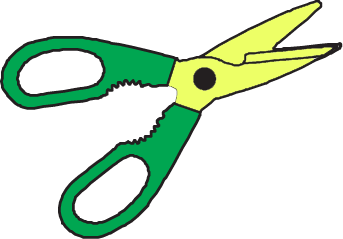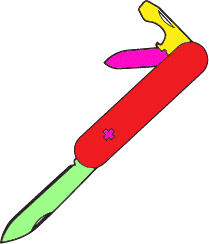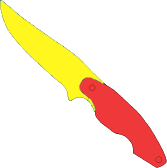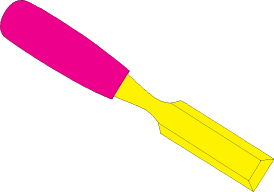Knife Sharpening
Our Sharpening Service
Unfortunately, all knives eventually dull and can no longer easily slice through food. A dull knife is more dangerous than a sharp knife since more force must be applied in order to cut. When more force is applied, the knife becomes more difficult to control making accidents more likely to happen. When cutting and slicing food to prepare a meal becomes difficult, or you notice a loss of control, it’s time to have your knives professionally sharpened.
Our professional sharpening service is a convenient way to keep your knives always sharp and ready to use. Our service is extremely fast and only takes about 1 or 2 business days. Our service is very convenient since you can drop off and pick-up your knives at our store during our regular business hours. Out-of-towners who wish to use our sharpening service can drop off their knives one week and pick them up the next.
Our professional knife sharpening service produces a razor sharp edge that is sharper than when the knife was new. We produce a remarkable sharp and uniform edge over the entire length of the knife from the heel to the tip. We achieve this by carefully sharpening and honing/polishing the edge until it is sharp enough to effortlessly glide through meat, vegetables, or fruit. We attain a very sharp edge and only remove a minimal amount of metal which makes your knife stay sharp longer.
After the sharpening and honing operations, the knife is cleaned and then tested for sharpness as part of our quality control procedure. The knife is then inserted into a paper sleeve to protect the sharpened edge from dulling during the trip home.
If you wish to keep your knife sharp after our professional sharpening, please read the section below “Tips For Keeping Knives Sharp”.
Cutting Blades That We Sharpen
![]()
Kitchen Knives
We sharpen all metal kitchen knives including chef knives, serrated bread knives, meat cleavers, utility knives, fillet knives, paring knives, bird's beak paring knives, butcher knives, slicing knives, boning knives, carving knives, santoku knives, etc.

Scissors
We sharpen most scissors including standard scissors, right or left-handed scissors, industrial scissors, dressmaker shears, tailor scissors and embroidery scissors.

Pocket Knives
We sharpen all pocket knives including single blade, multi-blade, plain edge and some serrated edge pocket knives.

Tactical Knives
We sharpen most tactical knives used by police, fire and military.

Hatchets and Axes
We sharpen camping hatchets and most axes.
![]()
Hunting and Fishing Knives
We sharpen all fixed blade knives which are generally used for hunting and fishing including fishing fillet knives.

Flat chisels
We sharpen flat wood chisels as well as metal cutting chisels.
Your Knife Needs To Be Professionally Sharpened
Most home kitchen knives will need to be professionally sharpened two to three times a year depending on their steel quality, usage and knife care. The fastest way to determine if a knife needs to be professionally sharpened is to test the edge. There are two quick and simple knife sharpness tests anyone can perform to determine when a knife needs sharpening.
The first is a simple paper cutting test. If you cannot easily cut a sheet of paper (copy paper, newspaper, magazine paper) using the entire length of the blade, the knife needs to be professionally sharpened. If the knife hesitates, tares or rips the paper, the edge is dull and the knife needs to be sharpened. A sharp knife will glide effortlessly through the paper without any resistance or hesitation. We use this test on every knife that we sharpen as part of our quality control to insure that we deliver a very sharp knife back to the customer.
The second knife sharpness test is the tomato slice. Slicing a tomato paper thin is a very good indicator of a knife’s sharpness. Dull knives squash tomatoes while sharp knives glide through them. If your knife does not glide through a tomato without squashing it, the knife is dull and needs to be professionally sharpened.
Tips For Keeping Knives Sharp
After a knife is professionally sharpened, here are some tips so that you can keep the edge as sharp as possible for as long as possible.
Buy the best knives that you can afford.
A high quality knife is made from high a carbon steel alloy and then properly tempered to maximize hardness and edge sharpness retention. The high quality steel knife is more difficult to sharpen, but retains its sharp edge longer than an inexpensive knife.
For example, we can sharpen a $5 knife as well as a $100 knife to razor sharpness, but the $5 knife will dull much faster than the $100 knife and will need to be sharpened many more times. Also, since the $100 knife will require less frequent sharpening, it is the eco-friendly choice since it will last much longer and can be passed down several generations. A high quality knife is a very good value and will outlast and outperform many cheap knives. The expression “you get what you pay for” is certainly true when it comes to knife purchases.
Hand wash don’t place in dish washer
Placing knives in the dishwasher where they can bump into other cutlery will dull a sharp knife very quickly. Also, the hot water, pressure and detergent in a dishwasher will damage or degrade the knife handles over a period of time.
Don’t mix knives together in a drawer along with other cutlery
Placing knives together in a drawer with other knives or other cutlery will dull a sharp knife very quickly. Knifes should never touch each other or other metal items.
Separate each knife
Knives must be separated from each other to preserve their sharpness. There are various ways of keeping knives from touching each other to prevent premature dulling. The knife block is an excellent way to separate knives. Drawer inserts that are specially made to keep each knife separate are also a good choice. If you have a vertical surface or wall near your cooking area, a magnetic rack would allow easy access and also keep knives separate. If you don’t have space for a knife block, dedicated drawer with knife inserts or a magnetic rack, a simple inexpensive solution is to buy plastic knife sleeves that fit each knife. These plastic sleeves protect the edge from dulling and allow you to keep them with other knives or cutlery. All of the above methods will separate knives and prevent knife edges from dulling due to metal-to-metal contact.
Use soft cutting boards
In order to keep knives sharp, use only soft cutting boards made from wood or plastic. Never cut or chop food on hard surfaces such as granite, aluminum, stainless steel, concrete, glass, ceramic plates or dishes. These hard surfaces will dull the knife edge very quickly.
Avoid Cutting Hard Food
Avoid cutting hard food items such as bones, fruit pits, egg shells etc. These can damage the sharp edge by causing nicks which will need to be repaired.
Don’t Use The Sharp knife edge as a scraper
Don’t use the sharp knife edge to move cut food from a cutting board to a skillet, bowl, plate, sink or the trash. Turn the knife over and use the spine of the knife to move cut-up food. Dragging the sharp edge across a cutting board will dull the edge.
Don’t Use The Knife As A Pry Bar
Don’t use the knife as a screwdriver or pry bar to separate frozen food. This will dull the edge and can cause a permanent bend or twist in the knife. Using the knife to separate frozen food can break off the tip which then must be repaired.
Use A Honing Steel Rod
A honing steel rod should be used to bring a dulling knife edge back to sharp. When a knife begins to dull, the microscopic wire edge begins to bend and roll resulting in a loss of sharpness. If the edge is not completely dull, “steeling” using a honing steel rod can bring the edge back to a reasonable sharpness. This should be done at least once a week to keep knives as sharp as possible.
Eventually, steeling the knife edge using the honing steel rod will not bring a dull edge back to a sharp condition. When this occurs, test the knife edge using either the paper cut test or the tomato slice test explained above. When the knife fails either of these sharpness tests, the blade needs to be professionally sharpened.
.png)